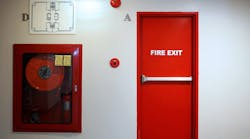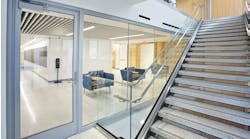After years of planning and construction, the last thing you want to happen is for your building to go up in flames. Taking steps to minimize the spread is essential to limiting the damage to a building, should a fire ever occur. Go beyond the basics of fire suppression, like sprinklers and fire extinguishers, and look at passive fire protection measures that contain a fire to its ignition point.
What is Passive Fire Protection?
Passive fire protection (PFP), also known as Built Fire Protection, helps safeguard people and limit damage to buildings and their contents from fire and smoke.
PFP systems work behind the scenes and are key to a fully integrated fire protection system. Passive systems support active fire protection (AFP), which includes fire sprinklers or sounding a fire alarm for fire detection and suppression. PFP does not aim to extinguish fire, but to prevent and minimize fire spread through thoughtful building compartmentalization and installation of fire-proof systems during construction.
What are the 4 Main Areas of Passive Fire Protection?
There are four main areas within the structural components that are designed to slow the fire’s spread by removing fuel sources. They include structural protection, opening protection, compartmentation and firestopping materials.
- Safeguard the building’s structural components with fireproofing materials that protect the structure’s integrity during a fire. Products like fireproof cladding, gypsum-based plaster, spray-on intumescent, or mineral wool wraps and insulation support structural protection, withstanding the fire effects.
- At every opening, implement opening protection to mitigate fire spread across floors. Fire-rated doors, framing and windows serve as fire and smoke barriers. So do fire and smoke dampers installed inside the building’s duct systems. These components restrict the spread of fire and smoke and enhance the building’s safety.
- Designs with concealed areas help compartmentalize the building and inhibit the spread of fire. Compartmentation of areas behind walls with firewalls, fire barriers, partitions and smoke barriers, as well as fire-rated floors and ceilings, contain fires and lessen the fire and smoke damage within a building.
- Fire can escape through holes throughout the building, so using firestopping materials can seal those openings. Problem areas include plumbing or electrical work. Fire-retardant coatings for cables and wires, as well as perimeter fire barriers, can be used to improve fire safety measures within the structure.
What PFP products are installed in buildings?
According to The Association for Specialist Fire Protection (ASFP), some of the products that improve a building’s fire safety include:
- Fire-resisting doors and fire door furniture
- Fire protection to the structural frame
- Fire shutters and curtains
- Fire-resisting external walls, curtain walls, etc.
- Compartment walls and partitions
- Suspended ceilings
The products can be installed within the building’s infrastructure or incorporated following construction. These products should be properly maintained and fit the purpose.
How Does Passive Fire Protection Save Buildings and Lives?
Proper installation of PFP systems limits the spread of fire from its source. The use of fireproofing materials can slow down the heating of a steel structure when it is exposed to fire. As steel heats up, it loses strength and stiffness, posing a risk to the structure’s stability as well as the safety of its occupants. Carbon steel loses 50% of its strength when it reaches 1,100 degrees F., but passive fire protection can slow the heat increase and allow people more time to evacuate the building while reducing irreparable damage or collapse before the flames are extinguished.



